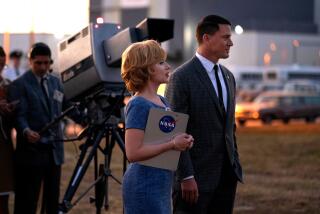With Mars Movies, at Least They Got the Color Right
- Share via
Men may be from Mars, but much ado has been made about how to get them back there. Last year, the much-anticipated Polar Lander caused elation that quickly changed to despair when the robot probe gave NASA the silent treatment. In August, NASA announced renewed efforts to explore the planet with two identical robot rovers scheduled to land on Mars days apart in 2004.
But in the year 2000, it’s Hollywood that’s made two recent Mars outings. Brian De Palma’s “Mission to Mars” was released by Disney in March and quickly disappeared from the moviegoing radar. The latest Mars venture, “Red Planet,” seems destined to do the same.
Chuck Pfarrer and Jonathan Lemkin’s screenplay has a five-man crew landing on Mars while the female commander (Carrie-Anne Moss) tends to the damaged spacecraft above. After a crash landing, the men must find a way back to the ship while danger lurks in the form of a robot (AMEE) gone amok and the Martian life forms. The Warner Bros. movie crash-landed in its opening weekend, taking in only $8.7 million (No. 5 on the box-office chart) amid withering reviews.
But what do critics--OK, and audiences--know? We asked a few real-life Mars men for their reaction to “Red Planet” and the earlier “Mission to Mars.” Steve Licata, Robert Reeves and Kevin Grazier of the Jet Propulsion Lab and David Paige, a professor at UCLA, were contacted for their assessments, scientific and otherwise, of these cinematic Mars missions.
Science fact:
All the scientists interviewed gave kudos to the films’ realistic red landscape. Licata, a software engineer on the Mars Global Surveyor project, noted, “It wasn’t just a red filter over the lens.” The use of a lag time between communications from the craft to Earth was similarly appreciated.
“The time lapse from here to Mars is about 20 minutes each way. You don’t have quick access to the experts,” explained Grazier, an investigation scientist working on the Cassini/Huygens mission to Saturn and Titan. “The astronauts would have to make decisions before they would get a confirmation from Houston. In some science-fiction movies, they cut this out because they don’t want to waste the time.”
Reeves, who works on computer software for space missions, agreed, saying that “lag time makes the movie slower but can adds to the dramatic tension.”
The expert panel thought the depiction of weightlessness was well-done. Licata mentioned that “flames and fire in a zero-gravity environment will expand in all directions. In ‘Red Planet,’ it was done correctly, with the smoke billowing out in all directions.”
Reeves thought the development of computer packets to translate information from one system to another was extremely fast, but added, “My hat’s off to Houston for coming up with a solution so quick.”
Science fictions:
Grazier maintained that technology and science were forgotten when it suited “Red Planet’s” story line. For example, Houston and the astronauts should have been aware of the atmospheric conditions on Mars.
Other snafus:
* The astronauts appeared to be walking in their space boots as if they were on Earth--movement on Mars, with less gravity, would involve more bounding.
* It would be highly unlikely that all the major man-made crafts would be in easy walking distance.
* The solar flare that caused damage to the ship was a ridiculous dramatic device--current technology can show solar flares before they occur. Houston could have warned the spaceship a few days in advance.
The meteor shower in “Mission to Mars” and the problems that ensued were more realistic than “Red Planet,” according to Licata. Both Licata and Grazier thought the “Red Planet” script ignored the importance of water. Commander Bowman’s (Moss) shower scene was a waste of precious water. Even the scene where the men urinate on Mars was criticized. “I know it was for comic relief, but urine is 97% water. They would probably be recycling their urine,” said Grazier.
Reeves suggested that the spacecraft’s engines “should have pointed the other way during entry into Mars’ orbit because generally you have to slow down to enter into orbit.” No one thought the landing craft or the men inside would have survived the impact of the dramatic air-bag landing.
Reeves was also amazed that “the ancient Pathfinder radio hooked into the ancient Soviet radio,” in “Red Planet.” “I guess they both got their parts from Radio Shack.”
Robot glitches:
Reeves thought the combat-mode software in the robot AMEE should have been erased before putting it on this important mission, noting: “Any sensible person would have erased it.”
Paige, who is teaching a graduate course on Mars, agreed. “You don’t need to be a rocket scientist to know that. It was like a ‘Lost in Space’ Robbie the Robot scenario. If you have a robot like AMEE with god-like powers, why bother to send people?’
Rating systems:
Both “Red Planet” and “Mission to Mars” lacked the pathos and good drama to satisfy these scientists, who picked Stanley Kubrick’s “2001: A Space Odyssey” as the best of the genre--technologically and dramatically. In fact, they thought the 1968 film was more forward-looking than this year’s Mars flicks. As these men continue to look toward Mars, they also continue to look for a good science-fiction movie on the red planet. For them, Hollywood remains a black hole for Mars flicks.
More to Read
Only good movies
Get the Indie Focus newsletter, Mark Olsen's weekly guide to the world of cinema.
You may occasionally receive promotional content from the Los Angeles Times.










